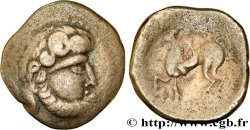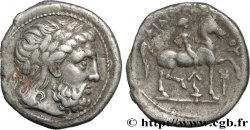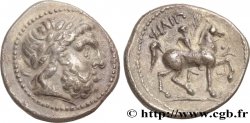v32_0959 - DANUBIAN CELTS - IMITATIONS OF THE TETRADRACHMS OF PHILIP II AND HIS SUCCESSORS Tétradrachme “au rameau”
MONNAIES 32 (2007)
Starting price : 380.00 €
Estimate : 600.00 €
unsold lot
Starting price : 380.00 €
Estimate : 600.00 €
unsold lot
Type : Tétradrachme “au rameau”
Date: (IIe-Ier siècles avant J.-C.)
Metal : silver
Diameter : 25,6 mm
Orientation dies : 9 h.
Weight : 13,72 g.
Rarity : R2
Coments on the condition:
Bon exemplaire, complet et homogène, avec une patine grise et brillante. On devine un défaut de métal ou une contremarque sur le portrait
Catalogue references :
Obverse
Obverse legend : ANÉPIGRAPHE.
Obverse description : Tête laurée de Zeus à droite ; grènetis.
Reverse
Reverse description : Cavalier au pas à droite, tenant une palme de la main droite ; le cheval lève l'antérieur à droite ; entre les jambes du cheval, une torche.
Reverse legend : FILIP - POU
Commentary
Si le statère d’or de Philippe II de Macédoine a servi de prototype à de nombreuses imitations gauloises, le tétradrachme n’a pas été imité en Gaule, mais reste principal sujet d’inspiration des monnaies pour les Celtes du Danube (LT. 9697-9767, 9768-9832, 9618-9630, 9870-9886). Les premières imitations furent frappées dans le premier quart du IIIe siècle avant J.-C. La fabrication des copies serviles, puis des imitations, enfin des frappes celtiques continuèrent pendant plus de deux siècles.
Au revers la torche correspond à Philippe III pour Amphipolis entre 323 et 316.
Au revers la torche correspond à Philippe III pour Amphipolis entre 323 et 316.








 Report a mistake
Report a mistake Print the page
Print the page Share my selection
Share my selection Ask a question
Ask a question Consign / sell
Consign / sell
 Full data
Full data









